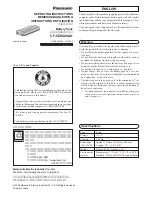
6
predetermined voltage. During this phase, the charging
voltage remains constant, while the charging current is
reduced to allow for the maximum proper internal chemical
energy transfer.
At the end of stage 2, the battery charger will beep and
automatically begin stage 3 of the charging process.
Stage 3 - top-off charge (fig. C)
Stage 3 is a top-off charge. The voltage is automatically
regulated and is reduced to a predetermined level while the
current is adjusted for a safe, effective battery charge. At the
conclusion of stage 3, the appliance will beep, signalling the
completion of the charging cycle.
Controls and Indicators
Function pushbuttons (fig. A)
The function pushbuttons, from left to right, are:
Battery type pushbutton (16) (Step 1).
This
pushbutton allows the user to select wet or
maintenance-free type of battery for efficient
and safe charge. Most automotive batteries are
wet batteries. Refer to the battery
manufacturer's specifications for the battery
type.
2/10/30A pushbutton (15) (charge rate
selector step 2).
This pushbutton allows the
user to select the charge rate based on battery
size. This selection and the actual battery charge
rate are monitored by the microprocessor and
displayed on the digital display (1). The battery
charger will stop charging if the rate is too fast or
too slow for the battery size or condition.
80 A pushbutton (12) (engine start).
This
pushbutton places the battery charger in an
engine start sequence. This pushbutton will not
be activated unless the battery charger is in the
30 A charge mode. Set the 2/10/30A pushbutton
(15) to 30 A first to activate this pushbutton.
Alternator check pushbutton (13).
This
pushbutton enables a five-second check that
measures the battery voltage. This check is
repeated at various electrical load levels and the
tests allow the user to determine if the alternator
can keep up with the loads. It can indicate
whether an alternator service may be required.
Battery voltage pushbutton (14).
This
pushbutton enables a check to measure the
battery voltage.
Equalize pushbutton (9)
. This is a recessed
pushbutton used to start the equalize process.
Control panel LEDs (fig. A)
WET LED (10)
- lights when the battery type
selector is on wet battery type
Maintenance free LED (11)
- lights when the
battery type selector is on maintenance free
battery type.
Float charge LED (6)
- lights when the
automatic charge monitoring is active. This
feature allows a battery to maintain its charge
over long periods of non-use. If there is any loss
of power to the battery charger, the battery
charger will automatically return to the default
settings once power is restored. Battery selector
type would be maintenance free.
Battery voltage LED (7)
- lights when the
battery voltage is displayed on the digital display
(1).
Alternator good LED (8)
- lights when load or
no load checks show that the alternator is
keeping up with the electrical load.
Charge rate selection (fig. A)
X
After the battery clamps (5) are correctly connected, plug in
the battery charger to a 230 Vac outlet. The battery charger
will show a circulating pattern on the digital display (1), to
indicate that power has been applied. Select the proper
charge current rate based on battery size.
Charging the battery (fig. A)
X
Press the battery type pushbutton (16) until the required
battery type LED lights (10) or (11).
Note:
The default selection is the maintenance free type
battery (11).
X
Press the 2/10/30A pushbutton (15) to begin charging at
the 2 A rate; the appliance sounds a beep and displays the
charging current. The battery charger starts charging at the
2 A rate automatically if the 2/10/30A pushbutton (15) is
not pressed within 3 minutes after applying ac power.
X
If the digital display (1) on the battery charger varies
between
F03
and the Amp rate, the battery is sulphated
and the battery charger is trying to give it some charge. If
after approximately 3 hours the digital display (1) just
shows
F03
, then the battery will not charge.
X
The battery charger occasionally sounds a beep and
displays
0.0
during self-test or charging stage changes.
This is normal.
80A
WET
GEL/AGM






























